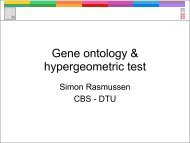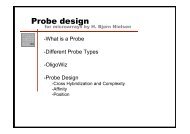Computational tools and Interoperability in Comparative ... - CBS
Computational tools and Interoperability in Comparative ... - CBS
Computational tools and Interoperability in Comparative ... - CBS
You also want an ePaper? Increase the reach of your titles
YUMPU automatically turns print PDFs into web optimized ePapers that Google loves.
3102 Nucleic Acids Research, 2007, Vol. 35, No. 9<br />
Table 1. The <strong>in</strong>itial number of rRNA sequences <strong>and</strong> the number of sequences excluded for different reasons.<br />
K<strong>in</strong>gdom Type Initial count Environmental samples Incomplete sequences Redundancy reduction Total <strong>in</strong> HMM<br />
Archaea 5S 58 0 0 10 48<br />
16S 589 239 471 287 76<br />
23S 37 0 18 8 15<br />
Bacteria 5S 461 0 0 101 360<br />
16S 12 107 1429 10 723 2485 743<br />
23S 398 0 155 130 127<br />
Eukaryotes 5S 316 0 0 33 283<br />
18S 6585 24 5222 836 979<br />
28S 157 0 91 8 58<br />
Environmental samples were excluded due to lack of phylogenetic <strong>in</strong>formation. Sequences with too many unknown nucleotides <strong>in</strong> either end of the<br />
sequence were excluded to improve HMM accuracy. Redundancy reduction was performed to reduce bias. Note that these groups may overlap. The<br />
last column <strong>in</strong>dicates the number of sequences used to build each HMM.<br />
nucleotides <strong>in</strong> either end of the sequence. A summary of<br />
the number of sequences removed dur<strong>in</strong>g curation of the<br />
alignments is shown <strong>in</strong> Table 1.<br />
The software package HMMer (15) version 2.3.2 was<br />
used to create HMMs from alignments where all columns<br />
conta<strong>in</strong><strong>in</strong>g only gaps had been removed. It was configured<br />
for nucleotides, <strong>and</strong> to compensate for skews <strong>in</strong> the<br />
nucleotide distribution a custom null model for each<br />
alignment was used. Although redundancy reduction had<br />
been performed, the Henikoff position-based weigh<strong>in</strong>g<br />
scheme (16) was used to reduce any rema<strong>in</strong><strong>in</strong>g biases.<br />
When us<strong>in</strong>g the HMMs to search genome sequences,<br />
the default alignment method was used: a match must<br />
span the entire model, <strong>and</strong> several matches may be found<br />
with<strong>in</strong> one sequence.<br />
With the aim of <strong>in</strong>creas<strong>in</strong>g the search speed, we<br />
determ<strong>in</strong>ed the 75 most conserved consecutive columns<br />
<strong>in</strong> each alignment, as illustrated <strong>in</strong> Figure 1, <strong>and</strong> produced<br />
‘spotter’ HMMs based on these. S<strong>in</strong>ce searches with the<br />
smaller spotter models would be considerably faster,<br />
we wanted to <strong>in</strong>vestigate the possibility of us<strong>in</strong>g the<br />
spotter to pre-screen for c<strong>and</strong>idates, us<strong>in</strong>g the full HMMs<br />
only on regions surround<strong>in</strong>g the spotter hits. Spotter <strong>and</strong><br />
full model searches were done separately. Spotter <strong>and</strong> full<br />
model predictions were matched based on whether they<br />
had overlapp<strong>in</strong>g nucleotides on the same str<strong>and</strong>. A l<strong>in</strong>ear<br />
regression was used to express spotter score <strong>in</strong> terms of<br />
full model score. Variation was estimated as l<strong>in</strong>ear <strong>in</strong> full<br />
model score with non-positive regression coefficients.<br />
Least squares estimates were used <strong>in</strong> both cases. Spotter<br />
scores were assumed to be miss<strong>in</strong>g when negative <strong>and</strong>,<br />
hence, assumed to follow a truncated normal distribution;<br />
expected scores <strong>and</strong> square deviations were used to replace<br />
miss<strong>in</strong>g values <strong>in</strong> the two regressions. From this model, we<br />
computed the lowest full model score, T99, for which there<br />
was at least a 99% likelihood of gett<strong>in</strong>g a correspond<strong>in</strong>g<br />
spotter hit, <strong>and</strong> the likelihood, Pm<strong>in</strong>, that a full model hit<br />
with the lowest found score should have a correspond<strong>in</strong>g<br />
spotter hit.<br />
Both the full HMMs <strong>and</strong> the spotter HMMs were run<br />
on all fully sequenced genomes found <strong>in</strong> the Genome Atlas<br />
database (listed <strong>in</strong> Supplementary Table S1). All predictions<br />
with non-negative score <strong>and</strong> E-value at most 100<br />
were reported. Only full model hits with E-value 50.01<br />
were accepted as reliable hits, but none with E-value<br />
between 0.01 <strong>and</strong> 100 were reported. As rRNAs with<strong>in</strong> a<br />
genome tend to be very similar, usually with at least 99%<br />
identity, different full model hits with<strong>in</strong> a genome<br />
correspond<strong>in</strong>g to actual rRNAs should be expected to<br />
have similar scores. However, we found a substantial<br />
number of hits with far lower scores which we assume to<br />
be pseudogenes, truncated rRNAs or otherwise nonfunctional<br />
rRNA copies. To ensure that these did not have<br />
an adverse effect on the analyses, we excluded full model<br />
hits hav<strong>in</strong>g a score less than 80% of the maximal score<br />
<strong>in</strong> that genome. These are listed <strong>in</strong> Supplementary<br />
Table S2.<br />
Annotations of rRNAs were obta<strong>in</strong>ed from GenBank.<br />
Unfortunately, rRNAs have not been annotated <strong>in</strong> a<br />
uniform manner <strong>and</strong> it was often unclear exactly what<br />
was annotated. In some cases, both the separate rRNAs<br />
<strong>and</strong> the full operon was annotated. In all such cases, the<br />
operons were longer than 5000 nt, <strong>and</strong> all annotations<br />
longer than that were thus excluded. In our experience,<br />
this affected only operons. In other cases, different pieces<br />
of the same gene had been annotated as separate entities.<br />
Thus, some predictions matched several annotation<br />
entries; these are listed <strong>in</strong> Supplementary Table S3. A<br />
prediction was considered to match an annotation if they<br />
were on the same str<strong>and</strong> <strong>and</strong> the length of their overlap<br />
was at least half the length of the shorter of the two; it was<br />
considered to be annotated if it matched at least one<br />
annotation. The deviation between annotated <strong>and</strong> predicted<br />
start <strong>and</strong> stop positions was also exam<strong>in</strong>ed, but<br />
predictions with multiple match<strong>in</strong>g annotations were<br />
excluded from this comparison.<br />
Additional analyses were performed for experimentally<br />
verified 16S <strong>in</strong> Anaplasma marg<strong>in</strong>ale St. Maries (M60313),<br />
Chlamydia muridarum Nigg (D85718), Escherichia coli<br />
K12 MG1655 (J01695), Sulfolobus tokodaii St. 7<br />
(AB022438), Thermus thermophilus HB8 (X07998) <strong>and</strong><br />
Nitrobacter hamburgensis X14 (L11663). <strong>Computational</strong><br />
speed was assessed on M. capricolum ATCC 27343<br />
(CP000123) Solibacter usitatus Ell<strong>in</strong>6076 (CP000473) <strong>and</strong><br />
Sargasso Sea data (AACY01000001-AACY01811372).<br />
All test searches reported were performed on an<br />
SGI Altix 3000 mach<strong>in</strong>e us<strong>in</strong>g one 1.3 GHz Itanium 2<br />
processor.









